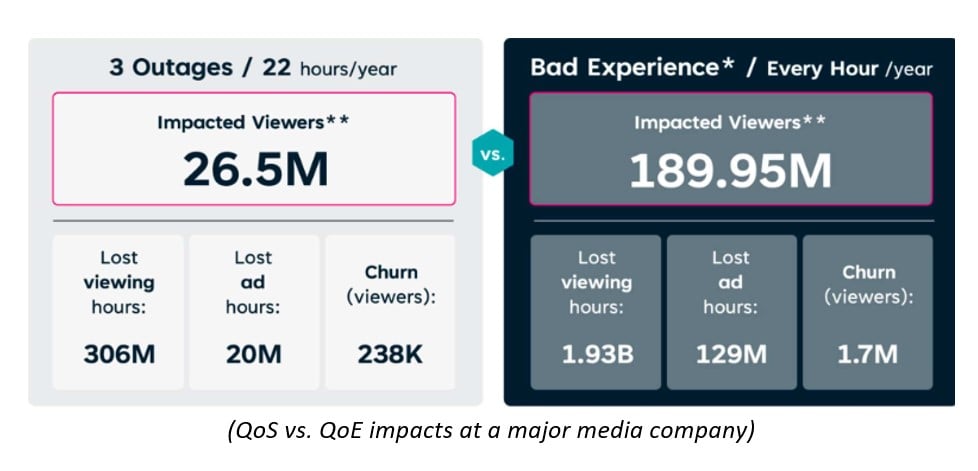
The impact of bad user experiences and the focus of a QoE approach far outweigh those of an outage, which is the priority for a QoS approach.
Technology companies cut more than 260,000 jobs in 2023, an unfortunate but necessary response to pandemic years marked by over-hiring, high inflation, and sluggish consumer demand. While the markets are showing positive signals early in 2024, businesses are facing new and intense pressure from investors to prioritize profits above all else. Nearly 60% of CEOs recently said the cost of inputs and of doing business will increase this year.
In short, businesses in this uncertain climate today must do more with less. Losing revenue already in hand is not an option. Unfortunately, for too many it is a reality. However, the solution requires not a shift in budgets, but rather a shift in mindset and methodology in how they approach a critically important leg of their business: operations.
By shifting from monitoring Quality of Service (QoS) to the more dynamic and insightful Quality of Experience (QoE) – which prioritizes the real-time experience of users – digital businesses this year can claw back lost customer engagement, lost revenue from purchases or subscriptions and reduce churn all while reducing costs. Here’s how.
The Quality-of-Service Approach
First, we need to understand the current status quo.
The Observability and Application Performance Monitoring (APM) markets have exploded into multi-billion-dollar industries in the past decade for their ability to transform how operations and engineering teams function and how they contribute to bottom lines. Businesses themselves pour millions of dollars into their IT operations departments every year because they have been told that to prioritize the user on the front end, they must first monitor on the back end the Four Golden Signals:
- Latency: The time it takes to service a request
- Traffic: How much demand is being placed on a system
- Errors: The rate of requests that fail
- Saturation: How “full” the service is
These performance metrics are important, but they don’t tell a business anything about how users are actually experiencing their digital product or service. They cannot answer important questions like, “Why is it taking my customers more than two minutes to sign up for my service, or are viewers stalling on the homepage?”
This in a nutshell is the QoS approach that digital businesses have been taking for over a decade. Many may want to monitor and manage the quality of experience users are having, but doing so through traditional QoS tooling is not feasible.
Why? First, the complexity involved in monitoring and measuring every event across every backend system and front-end device in real time is staggering. Second, to truly monitor quality of experience, businesses not only need to account for changes in things like server availability, location, memory utilization, device type, OS version, ISP congestion, and countless other dimensions, but they must also correlate how these dimensions interact with each other and with end users’ actions and state of the end user device and application at a global scale. This requires calculating trillions of data points every second, which will break a QoS monitoring tool trying to do this in real time.
See also: Customer Mastering: The Secret to Improving the Customer Experience
By the Numbers: QoS vs. QoE
The difference in these two operational approaches to ensuring quality and how they impact key metrics including revenue is best conveyed through data.
For nearly two decades, my company Conviva has worked with some of the largest media & entertainment companies in the world helping them drive time-critical decisions at every level of their organization. This means we have comprehensive insights into how operational approaches impact bottom lines.
A QoS approach looks at just that, service, which means the focus of operations teams is on how backend systems are performing. The priority metric in a QoS approach is system outages, which makes plenty of sense: if your systems are down, no one can engage with your service.
And in our data, we see significant impacts on businesses during major outages. A large, mature video publisher, for example, might see three system outages a year, equating to 22 hours of downtime, 305 million lost viewing hours, 20 million lost ad hours, and nearly 240 thousand lost subscribers.
For a business facing increasing costs and slimming budgets, a single outage can be a disaster.
But these metrics fail to show the full scope of issues for a simple reason: they don’t capture the quality of the user experience. A QoE approach looks not at system outages but rather at the experiences of users. While there may be only a few major outages a year, users encounter bad experiences every second of every day.
For the same type of large, mature media company, our data shows 189 million users are impacted annually by a bad experience, equating to a staggering 1.9 billion lost viewing hours, 129 million lost ad hours, and 1.7 million lost subscribers.

A New Methodology: Retaining Revenue with QoE
The data is clear: the impact of bad user experiences and the focus of a QoE approach far outweigh those of an outage, which is the priority for a QoS approach. Businesses focused solely on QoS are missing the most important view into their business.
So, how can digital businesses shift their operations mindset to focus on quality of experience and re-capture that lost revenue in a tight economic climate?
Instead of focusing on those four Golden Signals of a traditional QoS approach discussed earlier, businesses should focus on the customer experiences that generate revenue. These experiences will vary by industry and type of business. Here are some examples:
- Sign-up experience: Is my sign-up experience working properly right now? Am I losing customers at any stage due to delays or application errors? Is my sign-up conversion rate tracking as expected? Are there any anomalies for any customer cohort? How many customers leave due to a long sign-up process?
- Login experience: Is login working properly right now? Is my login success rate tracking normally? How many customers are leaving right now because it takes too long to log in? Is this happening in the OTP login flow or the trusted login flow?
- Search experience: Is search responding fast enough right now? Are customers able to successfully access search results quickly? How much engagement is lost because content takes too long to find?
We call these “moments that matter” because they map directly to revenue generation. We know that:
- Sign-up experience: 52% of users will drop if sign-up takes longer than 2 minutes.
- Login experience: 82% of users won’t return to a platform seven days after a failed login.
- Search experience: 23% of viewers will disengage if discovery takes longer than 11 minutes.
This broader approach that places the user and their real-time quality of experience at the center of operations is called Experience-Centric Observability (ECO). This new way of thinking and operating takes some getting used to. In this case, that business and revenue benefit is clear.
Not only does ECO, with a focus on QoE, reduce churn while boosting engagement and revenue, but it also reduces costs and saves in-house resources. When focusing solely on QoS, operations teams often first hear of an issue through social media and find themselves scrambling to find the issue with no clear guidance on priority. This causes them to deploy an army of expert engineers across multiple areas of the system to diagnose the issue, and even when an issue is found and fixed, the team is not sure if the problem is resolved since there is no direct monitoring of customer experience. This approach leads to more negative customer impact and massive resource costs.
But by focusing on QoE, organizations immediately put the attention on what matters most to customers and the business. This results in cost savings because 1) operations teams don’t have to analyze every piece of data, just the data that relates to QoE issues, and 2) they can prioritize investments – including capacity expansion, software development, or operational tools – on areas that most impact QoE.
Businesses today cannot afford to spend or lose revenue unnecessarily; margins are slim, competition is fierce and consumer expectations are sky high. Through a shift in mindset and approach, from focusing on QoS to QoE and embracing Experience-Centric Observability, digital businesses can enable a transformation that dramatically improves user experience, keeps users engaged while reducing operational costs.




























